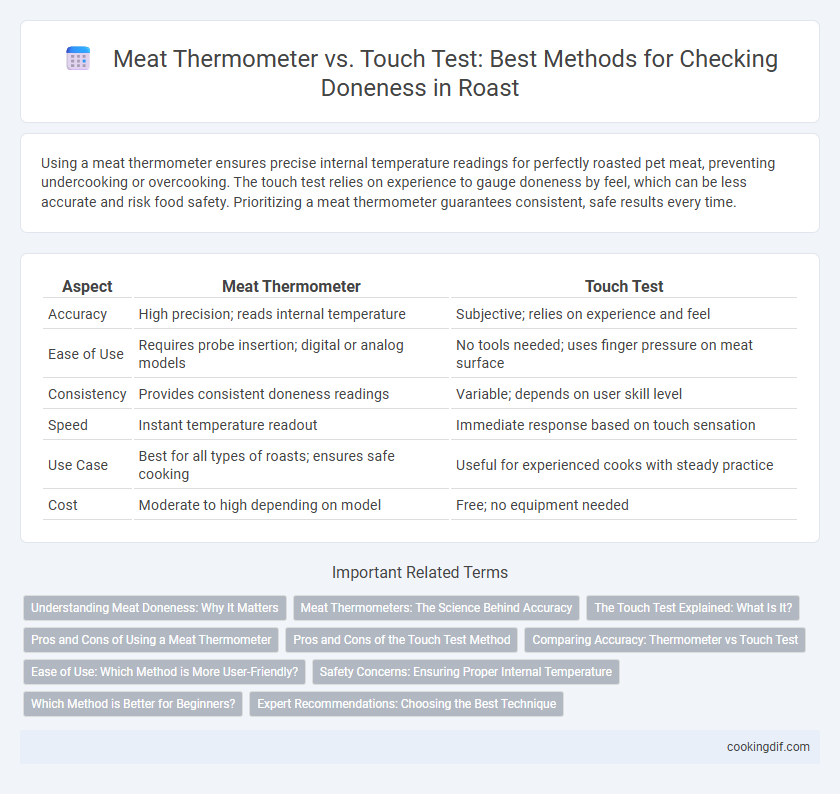Using a meat thermometer ensures precise internal temperature readings for perfectly roasted pet meat, preventing undercooking or overcooking. The touch test relies on experience to gauge doneness by feel, which can be less accurate and risk food safety. Prioritizing a meat thermometer guarantees consistent, safe results every time.
Table of Comparison
| Aspect | Meat Thermometer | Touch Test |
|---|---|---|
| Accuracy | High precision; reads internal temperature | Subjective; relies on experience and feel |
| Ease of Use | Requires probe insertion; digital or analog models | No tools needed; uses finger pressure on meat surface |
| Consistency | Provides consistent doneness readings | Variable; depends on user skill level |
| Speed | Instant temperature readout | Immediate response based on touch sensation |
| Use Case | Best for all types of roasts; ensures safe cooking | Useful for experienced cooks with steady practice |
| Cost | Moderate to high depending on model | Free; no equipment needed |
Understanding Meat Doneness: Why It Matters
Accurately determining meat doneness is crucial for both food safety and optimal flavor, with a meat thermometer providing precise internal temperature readings to ensure proper cooking. The touch test, relying on texture and firmness, offers a more subjective method that can vary based on experience and meat type. Understanding the importance of doneness helps prevent undercooked or overcooked roasts, enhancing overall dining satisfaction and reducing health risks.
Meat Thermometers: The Science Behind Accuracy
Meat thermometers provide precise internal temperature readings essential for ensuring roasts reach safe and optimal doneness, minimizing foodborne illness risks. Unlike the subjective touch test, thermometers rely on scientific temperature measurement, which correlates directly with meat protein denaturation levels. High-quality digital or instant-read thermometers enhance accuracy and consistency, making them the preferred tool for consistent roast cooking results.
The Touch Test Explained: What Is It?
The touch test is a traditional method used by chefs to estimate meat doneness by feeling the firmness of the roast and comparing it to different parts of the hand. For example, the soft feel of the thumb and index finger touching corresponds to rare meat, while a firmer feel, like the thumb and pinky finger pressing together, indicates well-done meat. Although less precise than a meat thermometer, the touch test provides a quick, intuitive way to gauge doneness without specialized tools.
Pros and Cons of Using a Meat Thermometer
A meat thermometer provides precise internal temperature readings, ensuring optimal roast doneness and food safety by avoiding undercooking or overcooking. Its main advantage lies in accuracy and reliability, while drawbacks include the need for device calibration and potential piercing, which may cause some juice loss. Compared to the touch test, the thermometer reduces guesswork, making it especially valuable for less experienced cooks or unfamiliar cuts.
Pros and Cons of the Touch Test Method
The touch test method for determining roast doneness offers immediate feedback without extra tools, making it convenient for experienced cooks familiar with meat textures. However, it is highly subjective and less accurate, risking undercooked or overcooked results, especially for novice chefs. Unlike meat thermometers that provide precise internal temperature readings, the touch test relies on muscle firmness, which can vary by meat type and thickness.
Comparing Accuracy: Thermometer vs Touch Test
Meat thermometers provide precise internal temperature readings, ensuring doneness accuracy by measuring core temperature, typically between 130degF to 165degF depending on desired level. The touch test relies on firmness variations felt through finger pressure, which can be subjective and less consistent, especially for less experienced cooks. Studies confirm thermometers reduce the risk of undercooking or overcooking, making them more reliable than touch tests for achieving optimal roast doneness.
Ease of Use: Which Method is More User-Friendly?
A meat thermometer offers precise and straightforward readings, making it highly user-friendly for achieving perfect doneness without guesswork. The touch test requires experience to accurately judge meat firmness and may lead to inconsistent results for beginners. Using a thermometer simplifies the cooking process, ensuring reliable temperature measurements with minimal effort.
Safety Concerns: Ensuring Proper Internal Temperature
Using a meat thermometer is the most reliable method to ensure roast safety by accurately measuring the internal temperature, preventing undercooked meat that could harbor harmful bacteria. The touch test relies on experience and can lead to inconsistent results, increasing the risk of foodborne illnesses. Maintaining the USDA-recommended internal temperature--145degF for beef, pork, and lamb with a resting time--is critical for safe consumption.
Which Method is Better for Beginners?
Using a meat thermometer offers precise temperature readings that ensure the roast reaches the ideal doneness, making it the best choice for beginners who may lack experience in judging meat by touch. The touch test requires skill to distinguish subtle differences in meat firmness, which can lead to undercooked or overcooked results for novices. Thermometers provide consistent accuracy and reduce guesswork, leading to perfectly cooked roasts every time.
Expert Recommendations: Choosing the Best Technique
Experts recommend using a meat thermometer over the touch test for accurate roast doneness, emphasizing precise internal temperature measurements to ensure food safety and optimal flavor. Professional chefs highlight that thermometers eliminate guesswork and provide consistent results, particularly important for large cuts of meat like beef, pork, and poultry. While the touch test offers a quick skill-based assessment, experts agree that investing in a reliable digital or instant-read thermometer is the best technique for achieving perfect roast doneness every time.
Meat thermometer vs touch test for doneness Infographic

 cookingdif.com
cookingdif.com